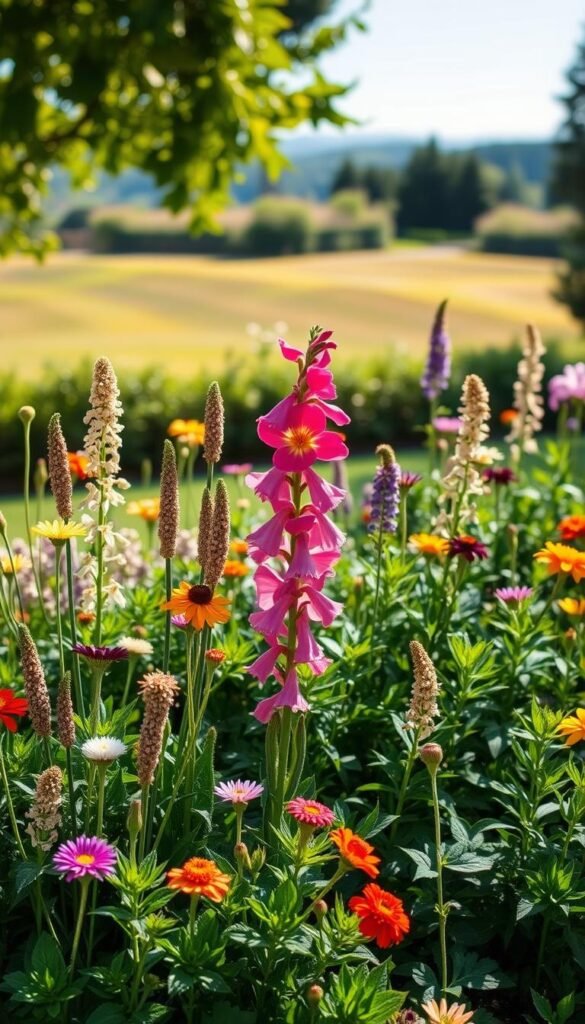Imagine stepping into a vibrant landscape where every plant works together like pieces of a living puzzle. Whether you prefer bold roses, cheerful zinnias, or elegant lilies, thoughtful arrangements turn ordinary yards into eye-catching displays. It’s not just about picking pretty blooms—it’s about crafting scenes that feel balanced, dynamic, and intentional.
Great planting areas balance three elements: varied leaf shapes, layered growth patterns, and standout features. Rough foliage next to delicate petals adds contrast, while taller stems behind compact bushes create depth. A single striking element—like a cluster of purple bellflowers—can anchor your design while guiding the viewer’s gaze.
This guide walks through professional techniques for building visual harmony. You’ll learn how to combine plants so they complement rather than compete. Discover why spacing matters as much as color choices, and how to use natural curves to enhance flow.
Ready to move beyond basic rows of annuals? Let’s explore how intentional layouts turn simple dirt patches into curated living art.
Setting the Stage: Planning Your Perfect Flower Bed
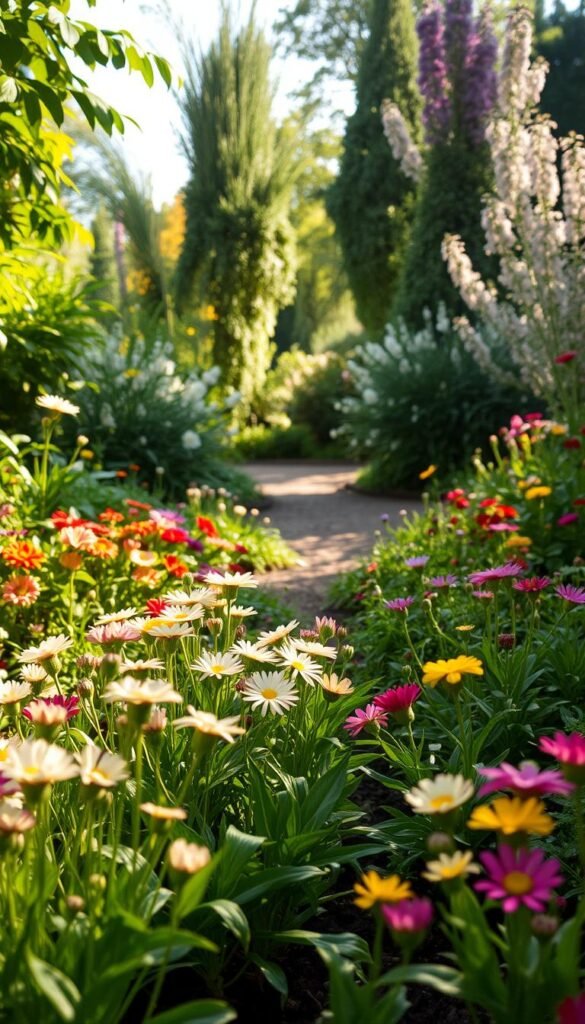
Creating a stunning outdoor display begins with smart preparation. Before grabbing your shovel, take time to map out how your vision fits your property’s unique characteristics. This groundwork ensures your efforts yield lasting results that blend seamlessly with your surroundings.
Understanding Your Space and Conditions
Start by measuring your yard’s dimensions and tracking sunlight patterns. Full-sun spots might host vibrant coneflowers, while shady corners could embrace hostas. Test your soil’s pH and drainage—sandy soils drain fast, while clay holds moisture longer.
Defining Your Style and Objectives
Do you lean toward crisp geometric lines or free-flowing wildflower charm? Your home’s architecture offers clues. A modern ranch might pair with minimalist grasses, while a Victorian cottage calls for overflowing hydrangeas. Consider color themes that either contrast boldly or whisper softly, like pairing coral daylilies with silver lamb’s ear.
| Style | Key Features | Plant Examples |
|---|---|---|
| Formal | Symmetrical layouts, trimmed edges | Boxwood, roses, tulips |
| Natural | Curved lines, mixed heights | Coneflowers, ornamental grasses |
| Modern | Minimalist groupings, monochromatic | Succulents, black-eyed Susans |
For those elevating your space, balance aesthetics with practicality. Choose native species that thrive locally, reducing maintenance while supporting local ecosystems.
Soil, Sunlight, and Seasonal Considerations
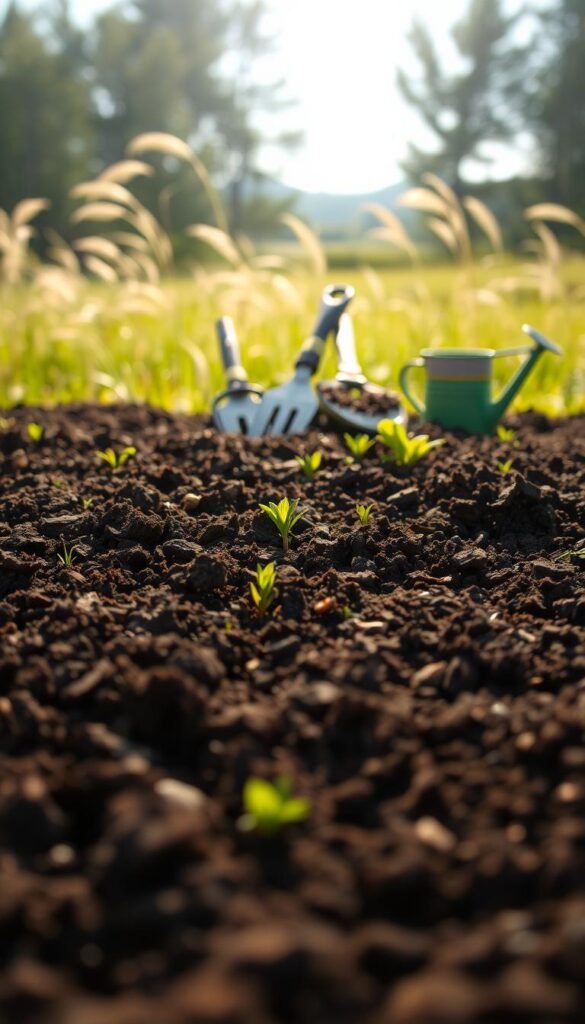
Healthy soil is the secret ingredient behind every thriving planting area. Without proper care, even the most carefully chosen plants struggle to reach their full potential. Let’s explore how to create the ideal growing environment while adapting to your local climate.
Preparing and Amending Your Soil
Start by testing your ground’s pH and nutrient levels. Home kits or local extension services provide quick insights. Most flowering varieties thrive in slightly acidic to neutral soil (6.0-7.0 pH).
Dig 6-8 inches deep to loosen compacted earth. Mix in compost or aged manure—about 3 inches worth—to boost drainage and moisture retention. For sandy soils, add peat moss. Clay-heavy areas benefit from coarse sand.
Choose fertilizers based on your test results. A balanced 10-10-10 blend works for general needs, while phosphorus-rich options encourage blooming. Remember: over-fertilizing harms more than helps.
Mulch acts like a protective blanket. Spread 2-3 inches of wood chips or shredded leaves around your low-maintenance flowers for raised beds. This reduces watering needs by up to 50% and keeps roots cool during summer spikes.
Track seasonal changes. Spring rains might require raised mounds to prevent waterlogging. In dry climates, consider drip irrigation systems. Observe how sunlight shifts across your space through the year—some spots that bake in July might stay shaded in April.
Choosing the Right Plants and Color Schemes
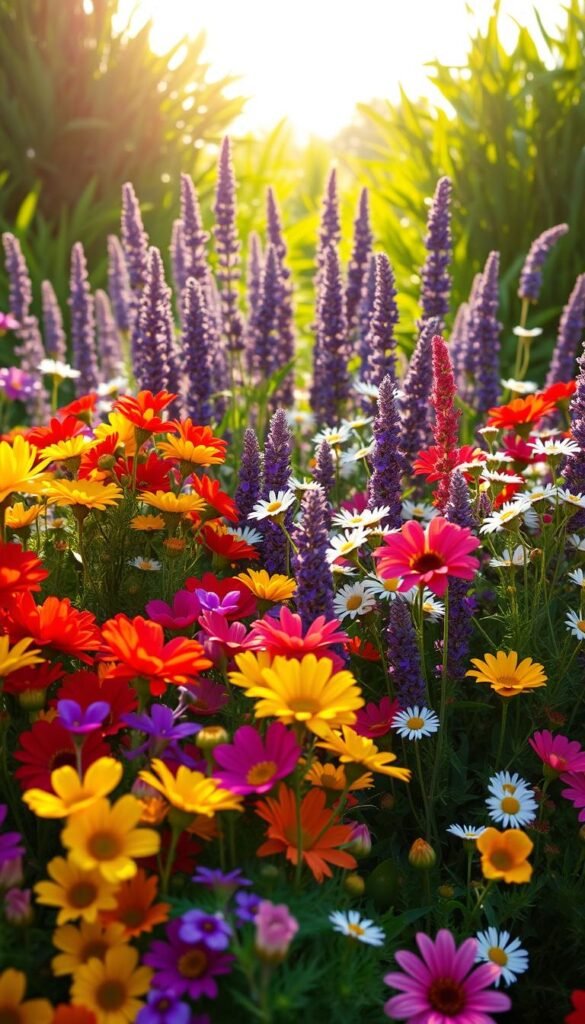
Transform your outdoor space into a year-round showcase by pairing smart plant choices with thoughtful color planning. Start by grouping species with matching needs—like sun-loving zinnias and drought-tolerant coneflowers—to ensure all your plants thrive under similar conditions.
Build your palette around 2-3 core hues for harmony. Soft pinks and purples create calming energy, while fiery reds and oranges demand attention. Blend shades within your chosen spectrum—pair pale lavender irises with deep violet salvias for subtle contrast.
| Bloom Period | Early Season | Mid Season | Late Season |
|---|---|---|---|
| Examples | Tulips, Daffodils | Roses, Daylilies | Sedum, Asters |
| Care Tip | Plant bulbs in fall | Deadhead weekly | Leave seed heads |
Mix reliable perennials like hydrangeas with annual flowers like cosmos for bursts of seasonal color. Always check mature sizes—place sprawling butterfly bushes behind compact azaleas to prevent crowding.
Don’t overlook foliage! Silver-toned artemisia or burgundy heuchera leaves add texture between blooms. This strategy keeps your arrangement striking even when fewer flowering plants are active.
Incorporating Texture and Height for Maximum Visual Impact
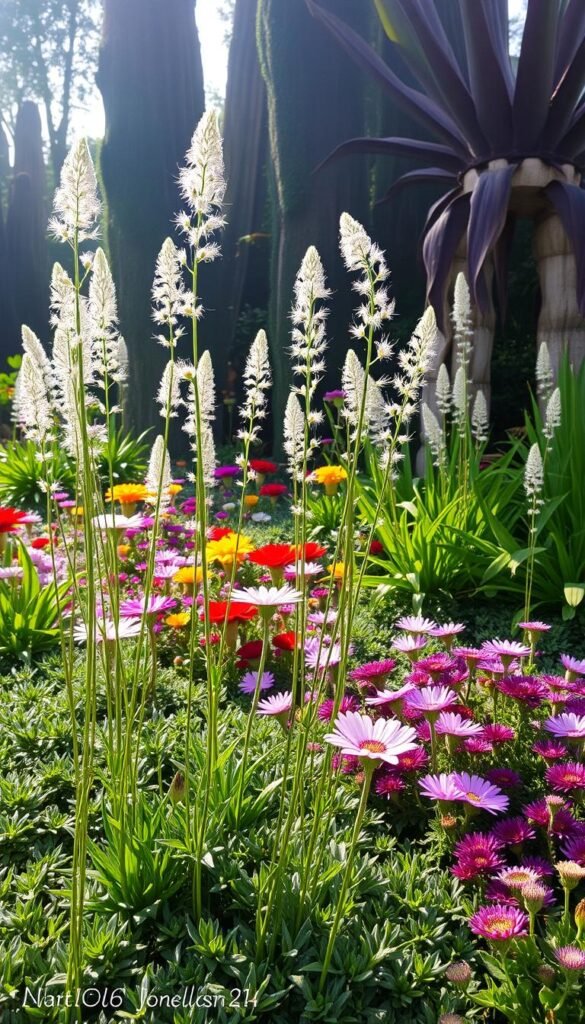
A well-structured planting area feels alive with movement and depth. By combining plants of varying sizes and surfaces, you craft an experience that invites closer inspection. The secret lies in strategic placement—guiding the eye upward, outward, and through every layer.
Layering with Tall, Mid, and Groundcover Plants
Start with taller plants like hollyhocks or delphiniums as your backdrop. These vertical elements frame your space while adding drama. Mid-height options such as lavender or coreopsis fill the middle zone, creating smooth transitions between levels.
Groundcovers like creeping thyme or sedum spill over edges, softening hard lines. This tiered approach ensures every plant gets noticed. Ornamental grasses, such as feather reed varieties, weave through other species with wispy texture that dances in sunlight.
| Plant Type | Height Range | Texture Examples |
|---|---|---|
| Tall Plants | 3-6 feet | Spiky blooms, broad leaves |
| Mid-Height | 1-3 feet | Feathery fronds, velvety petals |
| Groundcovers | Under 1 foot | Trailing vines, cushion-like mats |
Mix glossy hosta leaves with fuzzy lamb’s ear for tactile contrast. In winter, seed heads from coneflowers or dried grasses maintain visual interest. Remember: varied surfaces catch light differently throughout the day, keeping your arrangement dynamic.
Curved pathways or angled viewing spots let visitors appreciate every layer. Pair upright snapdragons with mounding heucheras to create rhythm. Your space becomes a living sculpture that evolves with the seasons.
Focal Points and Unique Edging Ideas
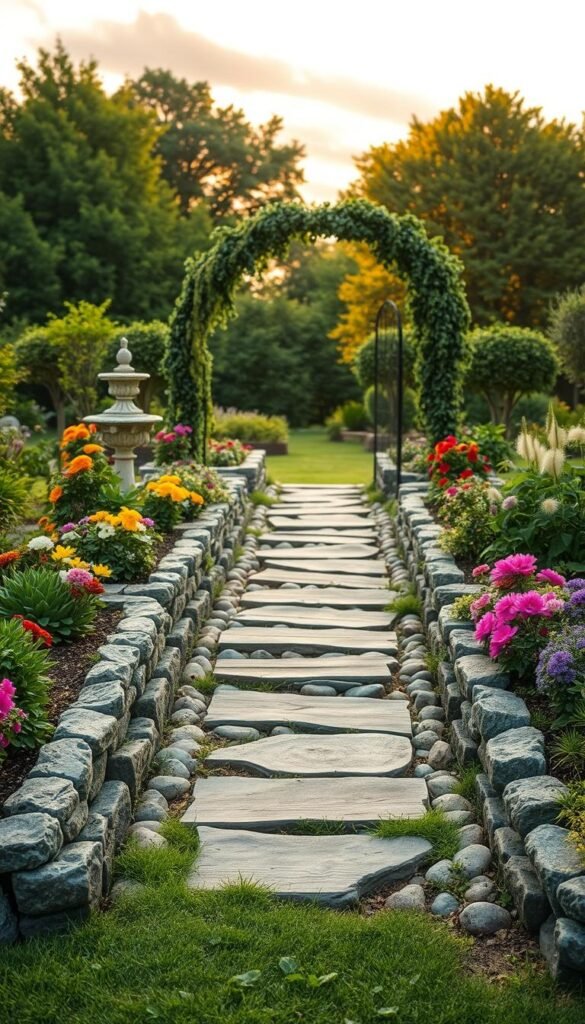
Every great outdoor space needs a visual anchor that pulls attention and organizes the design. A focal point could be a sculptural plant, decorative boulder, or artistic element that gives your arrangement purpose. Pair this with creative borders to frame your space like a living painting.
Creative Borders That Define Your Space
Edging does more than contain plants—it adds personality. Natural stone offers rugged charm, while reclaimed brick whispers vintage elegance. For budget-friendly options, try weathered wood planks or building raised beds with salvaged railroad ties.
| Material | Style | Durability |
|---|---|---|
| Natural Stone | Rustic | 20+ years |
| Reclaimed Brick | Vintage | 15-25 years |
| Weathered Wood | Cottage | 5-10 years |
| Limestone | Modern | 30+ years |
Curved lines soften formal landscapes, while angular edges complement contemporary designs. Pro tip: Bury edging materials 3 inches deep to block grass roots. Visit flower bed ideas for inspiration using terracotta tiles or geometric patterns.
Mix materials for unexpected contrast—pair smooth river rocks with rough-cut timber. Let your borders age gracefully; lichen-covered stones or mossy bricks develop character over time. Remember: your focal point should shine brightest, so keep edging subtle yet intentional.
Integrating Pollinator-Friendly and Native Species
Your backyard can become a bustling hub for nature’s hardest workers. By selecting the right plants, you’ll support struggling ecosystems while enjoying constant movement from winged visitors. Start by researching which species naturally thrive in your region—these choices create habitats while needing less upkeep.
Attracting Bees, Butterflies, and Other Wildlife
Different pollinators need specific flowers. Monarch butterflies seek milkweed for laying eggs, while bumblebees flock to tubular blooms like foxglove. Hummingbirds adore scarlet sage’s nectar-rich spikes. Plant in clusters so pollinators spot food sources easily.
| Plant | Attracts | Bloom Time | Key Feature |
|---|---|---|---|
| Milkweed | Monarch Butterflies | Summer | Host plant for larvae |
| Coneflower | Native Bees | June-September | Drought-tolerant |
| Goldenrod | 37+ Butterfly Species | Late Summer | Supports migrating insects |
Mix early and late bloomers to provide season-long sustenance. Crocuses kickstart spring feeding, while asters fuel fall migrations. Avoid pesticides—even organic ones can disrupt delicate ecosystems. Let leaf litter stay in winter; it shelters chrysalises and native bee larvae.
Native species like purple coneflower develop deep roots that prevent erosion. Their familiar shapes help local pollinators recognize food sources quickly. Remember: a messy corner with brush piles gives shelter to beneficial insects year-round.
Creating a Layered Flower Bed for Depth and Interest
Crafting a multi-level display transforms flat spaces into living tapestries. By stacking plants in distinct tiers, you guide the eye upward and outward. This approach maximizes visual impact in your flower bed while making every square foot count.
Start with tall structural varieties like foxglove or hollyhocks as your backdrop. These anchor the design while adding vertical drama. Mid-height options such as salvia or coreopsis fill the middle zone, bridging gaps between levels.
Finish with creeping phlox or sweet alyssum along edges to soften borders. For a relaxed cottage vibe, let varieties spill over edges naturally.
| Layer | Height Range | Examples |
|---|---|---|
| Backdrop | 3-6 feet | Delphiniums, ornamental grasses |
| Middle | 1-3 feet | Shasta daisies, lavender |
| Front | Under 1 foot | Sedum, thyme |
Choose bold color contrasts—like yellow marigolds against purple petunias—for excitement. Prefer subtlety? Blend peach cosmos with coral geraniums in an ombre effect.
Naturalistic drifts of 5-7 specimens feel more cohesive than single-file rows. Leave breathing room between groups so each layer matures without crowding.
Repeat key varieties throughout your design to create rhythm. This ties the flower bed together while preventing visual chaos. Plan for year-round interest by mixing early bloomers with late-season stars.
Designing a Charming Cottage Garden Look
Picture a scene where blooms tumble over weathered fences and bees hum between fragrant stems. The cottage garden aesthetic celebrates this balance of wild beauty and curated charm, inviting you to linger among its casual elegance.
Start with romantic classics like climbing roses and foxgloves. Let them mingle with lavender and daisies in loose clusters rather than perfect rows. This approach creates the illusion of nature taking the lead while you subtly guide the composition.
Soft pastels set the mood. Try pairing pale pink peonies with blue delphiniums, then add white Shasta daisies for contrast. For depth, tuck in burgundy columbines or violet salvias that peek through greenery.
| Plant | Feature | Season |
|---|---|---|
| Hollyhocks | Vertical accents | Summer |
| Sweet Peas | Fragrant vines | Spring-Fall |
| Lamb’s Ear | Silver foliage | Year-round |
Allow plants to self-seed freely—cosmos and poppies will fill gaps with cheerful volunteers. Let herbs like thyme spill onto pathways, releasing scent when brushed. This controlled chaos creates that quintessential cottage charm.
Include sensory stars like old-fashioned roses near seating areas. Their perfume enhances the immersive experience. Remember: slightly unruly edges and volunteer seedlings aren’t flaws—they’re essential to this timeless look.
Garden Flower Bed Ideas: Mixing Textures, Heights, and Focal Points
Turn heads with daring plant pairings that spark curiosity. Bold foliage and vibrant blooms create instant drama when balanced thoughtfully. In shaded corners, try Fatsia japonica’s speckled leaves towering over giant hostas—their contrasting shapes make both plants shine.
Uniting Contrast Through Smart Design
Sun-drenched spots thrive with tropical flair. Pair fiery red canna leaves with Dahlia ‘Vulcan’s’ dark petals. Add Colocasia’s elephant-ear foliage as a backdrop. The secret? Anchor wild textures with shared colors or growth patterns.
Spiky grasses next to soft ferns add energy without chaos. For cohesion, repeat one element—like silver undertones in lamb’s ear and artemisia. Even striking arrangements need harmony.
Want year-round impact? Blend evergreen structure with seasonal stars. Discover how brighten compact spaces using similar principles in pots. Remember: nature loves contrast, but balance keeps designs feeling intentional.

